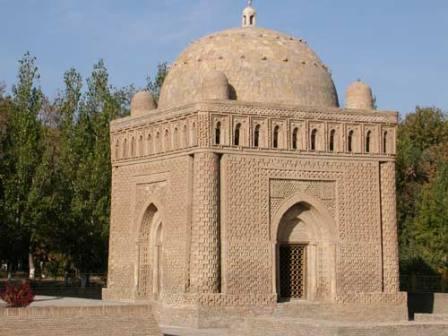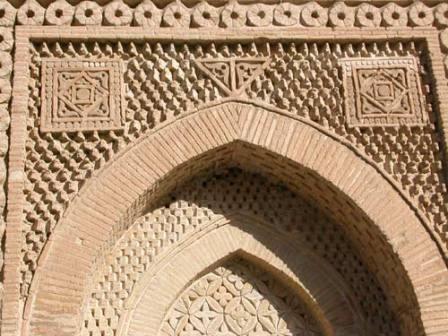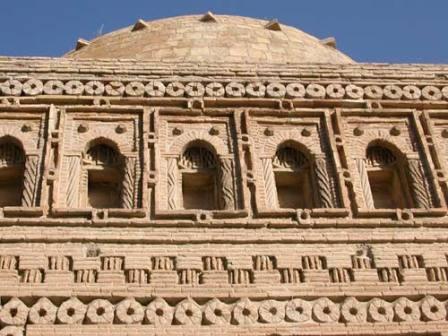|
Category
|
Mausoleum of Samanids
It is recognized that the Samanids Mausoleum is the oldest monument of Islamic architecture in Central Asia, and the only surviving architectural monument of the Samanid Dynasty. Its importance is even more significant in light of the fact that Islam prohibits the construction of indoor mausoleums, so in the case of the Mausoleum of Samanids maybe we all are talking about a very early departure from this rule, and thus, the mausoleum of the first of this kind of history of Islamic architecture. Architecturally the building of the Mausoleum of the Samanids organized as well as were built the ancient Zoroastrian fire temples. Thus, the Mausoleum of the Samanids is inextricably linked with the traditions of pre-arabian time, what is the overall composition and convince many of the elements of architectural decoration. At the same time, the architectural decisions of the mausoleum, pronounced and progressive tendencies, which determined the further development of Central Asian architectural style, the search for new forms and new solutions.
Samanid state at the time of its heyday in the tenth century. included almost the entire territory of modern Uzbekistan, Tajikistan and Turkmenistan, as well as the north-east and the main part of the territory of modern Afghanistan. And the capital of the Samanids - Bukhara, became one of the largest cities in the Muslim world. The time of the Samanids was the heyday of the economy and culture. The mausoleum, built entirely of brick, the plan is square with a side of the square of 10 m. All four sides are open for review. At the four corners erected three-quarter columns. On the columns rests delicate arcade that has over 10 arches on each side. At the corners of the roof are small domes, which are slightly shifted toward the center axis of the columns. In the center of the roof - the main dome with a small lantern.
Inside the building, the four corner arches give the room an octagonal shape. In the corners of the octagon are small decorative columns with capitals. Above the columns is a narrow shestnadtsatiugolny frieze, which goes into the vault of the dome. Depending on the lighting, the Mausoleum of the Samanids appearance is changing, thanks to cleverly executed decorative brickwork. The building is well preserved to our time and maintained in excellent condition. |
 Not far from the Registan Square, at the Samanids park, broken at the site of an ancient cemetery, shining under the bright sun, the pearl of medieval Bukhara and Central Asian architecture - the Mausoleum of Samanids. Samanids Mausoleum, according to legend, was built by Ismail Samani - the founder of the Samanids state, for his father Ahmad ibn Asad. Later, the mausoleum of Samanids became a dynastic tomb: here was buried Ismail, and then, according to the inscription over the entrance, his grandson. Time of the erection of the mausoleum of Ismail Samani is between 892 and 943 years old.
Not far from the Registan Square, at the Samanids park, broken at the site of an ancient cemetery, shining under the bright sun, the pearl of medieval Bukhara and Central Asian architecture - the Mausoleum of Samanids. Samanids Mausoleum, according to legend, was built by Ismail Samani - the founder of the Samanids state, for his father Ahmad ibn Asad. Later, the mausoleum of Samanids became a dynastic tomb: here was buried Ismail, and then, according to the inscription over the entrance, his grandson. Time of the erection of the mausoleum of Ismail Samani is between 892 and 943 years old. This is very typical for the era of the Samanids, in activities which can be traced as it were, two contradictory trends. On the one hand, they - the typical Muslim rulers, the distributors of Islam among the many "infidels" of their neighbors. On the other - they are the pre-Islamic tradition revived that were not in conflict with the tenets of Islam and of contemporary era.
This is very typical for the era of the Samanids, in activities which can be traced as it were, two contradictory trends. On the one hand, they - the typical Muslim rulers, the distributors of Islam among the many "infidels" of their neighbors. On the other - they are the pre-Islamic tradition revived that were not in conflict with the tenets of Islam and of contemporary era. In each of the four walls of a rectangular doors are built into complex framing. The outer decorative frame of the doorway goes first in the great, and then in a small arch. Only the input frame decorated with terracotta architectural details. Decoration of the rest of the building serves as a decorative brickwork.
In each of the four walls of a rectangular doors are built into complex framing. The outer decorative frame of the doorway goes first in the great, and then in a small arch. Only the input frame decorated with terracotta architectural details. Decoration of the rest of the building serves as a decorative brickwork.














